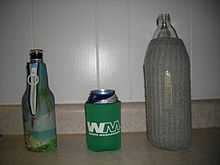Koozie

A koozie (pronunciation: /ˈkuːzi/ KOO-zee) is a fabric or foam sleeve that is designed to thermally insulate a beverage container, like a can or bottle.
Name, origin, and trademark dispute
The name "Koozie" was coined as a trademark, according to Norwood Promotional Products. It was originally a trademark of the Texas company Radio Cap Corporation (RCC). RCC registered the trademark in 1980; but the registration lapsed in 2001. Norwood had bought RCC in 1989, and it re-registered the trademark in February 2004.[1][2] Today, Société Bic owns the trademark for KOOZIE, as well as RCC KOOZIE.
Other names for the koozie are:
- "beer rubber" [3]
- "bawdle"[1]
- "beer hugger"[1]
- "beer huggie"[1]
- "beer koozie"
- "beer sleeve"
- "bottle jacket"
- "can cooler"[1]
- "candom"
- "coastie"
- "coldy-holdy"[1]
- "coolie"[1]
- "coosie"
- "Custom Koozie"[4]
- "cozy"[1][5]
- "insulated can holder"
In Australia it is called a "stubby holder" due to the shape of the 375 millilitres (13.2 imp fl oz; 12.7 US fl oz) bottles of beer being shorter and fatter compared to the more slender 330 millilitres (12 imp fl oz; 11 US fl oz) bottles.
Norwood has been in a dispute, on-and-off over several years in the 2000s, over the Koozie trademark status with an online retail business called Kustom Koozies.[6] Norwood asserts that names such as beer hugger, can cooler, and huggie do not infringe its trademark, but that koozie, coozie, coolie, and cozy do.[1][2] Kustom Koozies asserted in 2005 that the trademark had become generic.[1][2] In the years since, Norwood and Kustom Koozies came to a licensing agreement over the use of the trademark, but by 2009 they were in dispute again, as Kustom Koozies tried and failed to cancel the trademark licensing agreement in response to Norwood instructing it to make certain changes to its website, one of which was that "Koozie" should be set out in all-capital letters as "KOOZIE," and another being that the registered trademark symbol "®" be used to identify genuine Norwood KOOZIES.[7]
Use
Koozies are used to insulate a chilled beverage from warming by conduction and heat radiation, like a hand, warm air, or sunlight. Using a koozie can reduce the rate a drink warms in the sun by up to 50%.[8]
Secondary uses include easily identifying one's beverage from another person's and for marketing. By imprinting on the koozie many different companies have used the koozie as a promotional giveaway because it is not only inexpensive to manufacture, but its frequent use is more likely to bring the company's name to a household presence. Originally a logo or image was screen-printed on a round foam cylinder with a foam base, which generally has a hole at the base to ease inserting and removing beverage containers.
Materials and styles
The koozie has evolved in both material and style. Materials used include leather,[9] neoprene, EVA, polyester, vinyl, and various open-cell and closed-cell foams. There are koozies for 40 oz. bottles, and adjustable koozies that fit different beverage container sizes.
See also
References
- ↑ 1.0 1.1 1.2 1.3 1.4 1.5 1.6 1.7 1.8 1.9 Snell 2006.
- ↑ 2.0 2.1 2.2 Glenn 2005.
- ↑ http://www.beerrubbers.com/About-Us.html''. Missing or empty
|title=(help); - ↑ Express, Imprint. "Express Imprint: Custom Koozies".
- ↑ Freeman 2009.
- ↑ http://www.kustomkoozies.com
- ↑ Farrell 2012.
- ↑ Tillett, Darren. "Performance and properties of commonly used drink insulators". Retrieved 14 January 2013.
- ↑ For example https://www.etsy.com/listing/181556145/handmade-leather-beer-coozie-hand/
Sources
- Farrell, Kenan (2012-01-06). "Indiana Trademark Litigation Update — Norwood Promotional Products v. KustomKoozies (DECISION)". IndianaIntellecualProperty web log.
- Freeman, Jan (2009-01-04). "Why is that beer jacket a 'koozie'?". The Boston Globe (Boston.com). Retrieved 2010-09-15.
- Snell, Teddye (2006-01-20). "Drinkthink: Keeping it hot and cold". Tahlequah Daily Press. Archived from the original on 27 October 2014.